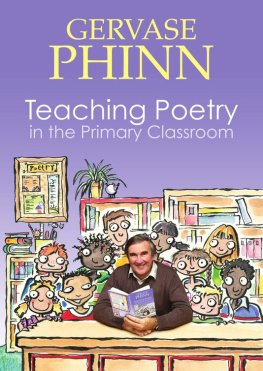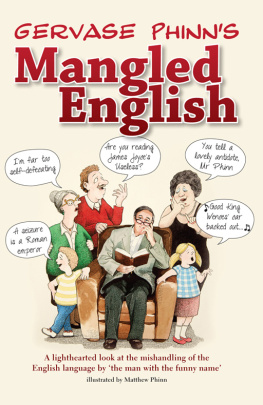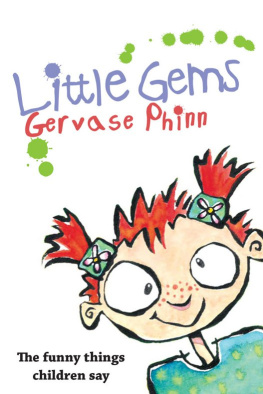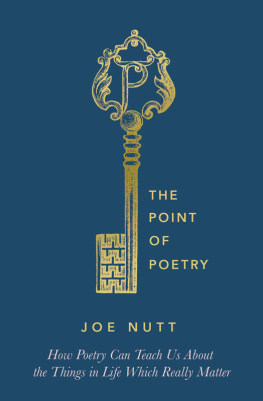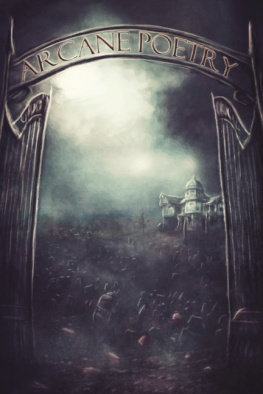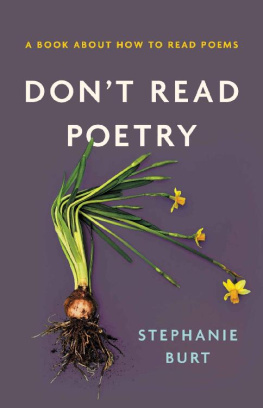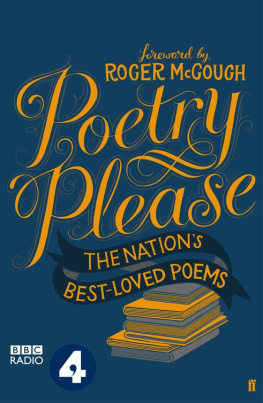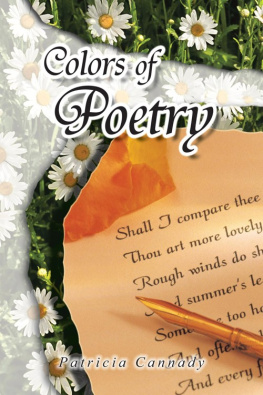I think that poetry should surprise by fine excess and not by singularityit should strike the reader as a reading of his own highest thoughts, and appear almost a remembrance. Its touches of beauty should never be halfway, thereby making the reader breathless instead of content; the rise, the progress, the setting of imagery should like the sun come natural to himshine over him and set soberly although in magnificence leaving him in the luxury of twilightbut it is easier to think what poetry should be than to write itand this leads me on to another axiom. That if poetry comes not as naturally as the leaves to a tree it had better not come at all. John Keats in a Letter to John Taylor, 27 February 1818 Poetry has great educative power, but in many schools it suffers from lack of commitment, misunderstanding, and the wrong kind of orientation. There are few more rewarding experiences in all English teaching than when the teacher and pupil meet in the enjoyment of a poem. A Language for Life: The Bullock Report Poetry is a most wonderful art: to read, to listen to, to attempt.
It takes the gift of language and pays it the respect of fashioning it into the finest forms while retaining a grip on the human-measure of life. For many, it is dinned into their unwilling heads at school, trailed across their noses in restless adolescence and ever after considered a part of another world. Not the real ordinary world. Yet the real world has been the poets prime concern. And many of us believe that the real world has been represented more accurately and powerfully by poets than by anyone else. Melvyn Bragg in How to Enjoy Poetry by Vernon Scannell If I read a book [and] it makes my whole body feel so cold no fire can ever warm me, I know that is poetry.
Im very good at poetry you know. The speaker, with all the honesty, enthusiasm and confidence of an eight year old, was called Helen. I met her on my visit to an infant school to look at the range of writing undertaken by the children. Would you like to see my poems? she continued.
I would love to, I replied. She smiled. Ill fetch my portfolio. Helen was rightshe was good at poetry. Her folder of poems contained a colourful description of the local canal: straight and long like the dark green stalk of a tall tulip; a holiday memory featuring her father who growled and grunted, sighed and shouted when the car would not start; rhyming verse about the supermarket where the shelves were full of packets of sugar and cans of beans, Bananas and apples and tangerines, Carrots and onions, potatoes and greens, and the thoughts of a Roman soldier, cold and alone and away from home. I asked if I could make a copy of her latest poem.
If you wait a minute, she said, Ill give you a print out. Here is her lively descriptive verse:
From the school window I can see where a mole has been burrowing. The field is lumpy with little brown hills of soil. Down below where its dark and damp, He digs and digs with big flat paws, Looking for a juicy worm.
Do you write poetry? Helen asked, handing me a copy of her poem. Yes I do, I replied.
Do you get the rhythms? Yes. And the rhymes? Sometimes. Do you illustrate your poems? No, Im afraid I dont. She smiled. I do, she said, I think it makes them look nicer on the page. And why are you so good at writing poetry? I asked.
She sighed. Oh, I dont really know. I like to read them. We have lots of poetry books in our classroom. Our teacher likes poems and she reads a poem to us every day after shes marked the register and we always write a poem when we do our topic. With this kind of environment and encouragement it should come as no surprise that Helen is such an accomplished poet.
Helens teacher is an enthusiast and her passion for poetry is infectious. Listed below are some of the things she does to keep herself well-informed and to encourage her pupils to enjoy, appreciate and understand the poetry she presents to them. Provides a wide selection of good, appropriate poetry anthologies in the book corner of the classroom. This collection includes pop-up books, nursery rhymes, modern and traditional anthologies, scripts and poems for reading aloud, verse on tape, poetry posters and cards. Reads a wide selection of poems to the children over the year: poems that make the children laugh, think and feel sad, poems with strong rhythms and gentle lyrics, verse from Africa, Asia, Australia and the US, as well as from the British Isles. Allows some time for the children to browse among the poetry and reading books and for them to read poems quietly, listen to them on tape and read the poems of other children.
Collects the childrens poemssome hand-written and illustrated, others word-processedin a class anthology. Encourages the children to keep a special book for writing in their favourite poems. Collects together her own favourite poems in a folder and compiles a list, which she adds to regularly, of poetry suitable for the children. Encourages the children to keep a special folder (the portfolio) of their own poems. Reads a short, entertaining or challenging poem each day. Sometimes she encourages the pupils to talk about the poem but on other occasions nothing is saidthe children just enjoy the experience.
Integrates poetry into the topic work the children undertake. Uses poems for handwriting practice. Encourages the children to perform their own poems and published verse in the classroom and at assembly. Enters children for poetry competitions. Encourages children to learn poems by heart. Invites writers into school to work with the children and share their experience of the process of writingwhere their ideas come from, the research they have to undertake, how they draft and revise, proof-read and submit for publication.
Organises Book Weeks during which teachers, parents, writers and advisers visit the school to contribute to the various activities. Mounts colourful and interesting displays of the childrens poetry in the classroom and along the corridors. Shows children how real poets draft, redraft, alter, edit and refine their work. Talks to the children about poetic techniques and devices: rhythm, rhyme, imagery, contrast, repetition, figures of speech, as they arise in the poems she reads to them and in the childrens own efforts. Uses paintings, line drawings, photographs, drama and music as stimuli for the childrens poetic writing. Encourages the children to write in a range of structures: snapshot poems, haiku, alphabet poems, concrete verse, acrostics, limericks, riddles, free and rhyming verse.
Keeps up with her reading of poetry by visiting the School Library Service HQ, being a member the Poetry Society, reading the reviews in The SchoolLibrarian and other journals and keeping in close and regular contact with local bookshops. Providing this sort of rich and stimulating environment is essential if poetry is to flourish. In addition children need specific guidance and ideas to start them off. It is not enough to merely give children a topic and expect them to write a poem. Over the years as a teacher, adviser, school inspector and visiting poet, I have worked with primary and infant school teachers and their pupils in an effort to give poetry a higher profile, promote its enjoyment and appreciation, and encourage the children to write a range of verse.

